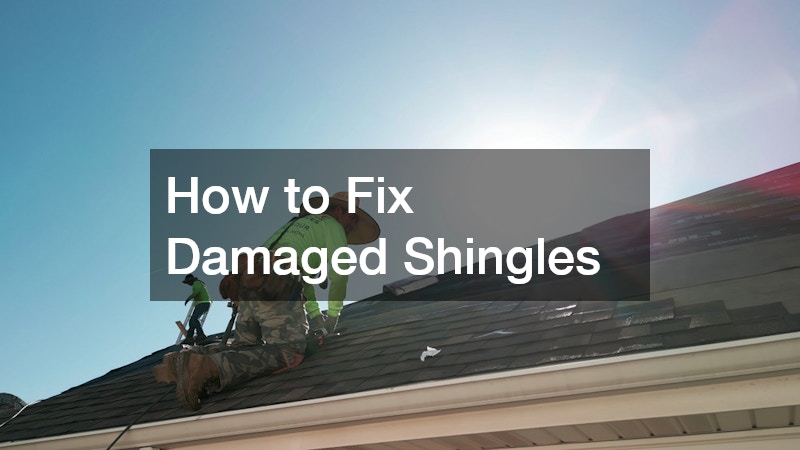Maintaining a healthy roof is crucial for the longevity and safety of your home. One of the most common issues homeowners face is damaged shingles. This guide will walk you through the steps of identifying, assessing, and repairing damaged shingles as part of effective roof repair.
Identifying Damaged Shingles
The first step in roof repair is to identify damaged shingles, which typically involves a detailed inspection of your roof. You may notice physical signs of wear such as curling or missing shingles.
Weather elements like wind, rain, and snow are primary culprits that cause shingle damage over time. Sometimes, you can spot granule loss in your gutters, indicating deteriorating shingles. Regular inspections, ideally twice a year, can help catch these issues early, minimizing the need for more extensive roof repair.
Conducting a roof inspection doesn’t always require professional help; using binoculars for a ground-level look can detect conspicuous damage. Look for inconsistent patterns, discoloration, or spots where shingles seem lifted. Be sure to inspect valleys and areas around chimneys closely, as these spots are particularly prone to wear and leaks. While walking on your roof, exercise extreme caution to avoid causing additional damage to the shingles. When in doubt, opt for professional roof repair services to pinpoint less obvious issues.
In addition to visual cues, interior signs like water stains on ceilings or moisture in the attic can also indicate damaged shingles. Often, these signs appear after heavy rain or storms that exploit existing weaknesses in the roof. Remember, early detection significantly contributes to cost-effective roof repair. Installing a drip edge can sometimes prevent water from entering under the lower ends of the shingles. Ultimately, consistent checks and prompt repairs are pivotal in preventing extensive damage.
Assessing the Extent of Damage
Once you have identified damaged shingles, assessing the extent of damage is essential for determining the appropriate roof repair action. Consider whether the damage is isolated to a single area or widespread. If the damage is significant, a professional assessment might be necessary to suggest whether a full replacement is more cost-efficient than repairing small sections. Keep in mind the age of your roof, as older roofs may not benefit as much from patch repairs. Professional roof repair firms can provide comprehensive evaluations, potentially spotting underlying issues that are not immediately visible.
Evaluate the type and material of your shingles, as different materials have varied lifespans and response to damage. For instance, asphalt shingles might require a different repair approach compared to cedar or metal roofing. Understanding the material characteristics aids in choosing the right repair products and techniques. Should you decide to perform a DIY repair, ensure you have researched thoroughly or consulted with a professional about the best practices. Also, be aware of weather conditions, as cooler temperatures may render shingles brittle, complicating repair efforts.
Documenting your findings can prove valuable, especially if you need to file an insurance claim or consult a professional later. Take clear photographs from various angles, capturing all visible signs of damage. This evidence helps roofing experts give more informed advice, and may also streamline insurance claim processes. Additionally, figure out if the damage is covered under your homeowner’s insurance policy to offset repair costs. Compiling a repair budget based on estimates from multiple contractors can aid in effective financial planning.
Repairing Damaged Shingles
Repairing damaged shingles is a task that requires precision and patience to ensure a lasting solution. Begin by gently lifting the surrounding shingles using a flat pry bar. After lifting, remove the nails securing the damaged shingle, and slide it out. Replace it with a new shingle, securing it with nails and sealing the edges with asphalt roofing cement. Ensure each step is performed carefully to prevent adjacent shingles from becoming loosened during your roof repair efforts.
Choosing the right shingles for replacement is crucial to maintain the integrity and appearance of your roof. Select shingles that match the type, color, and style of your existing roof to ensure uniformity. Additionally, consider purchasing a few extra shingles after repairs, which can be used in future repairs if needed. When applying the new shingle, make sure the overlap mimics the original setup to prevent leaks. Warranties on new shingles can offer long-term protection and peace of mind.
For widespread damage, consider consulting with a roofing professional to explore comprehensive roof repair solutions, possibly involving advanced materials like synthetic underlayment for better protection. They can offer insights into modern techniques and materials that can enhance durability and energy efficiency. Professional repairs might be necessary in complex situations, like when damage spans multiple layers or involves structural components. Avoid delaying repairs once you identify damage, as neglect could lead to further structural and financial issues. Frequent maintenance and timely repairs are investments toward the longevity of your roof.
Preventative Measures and Maintenance
To minimize future damage, implementing proactive roof maintenance can extend the lifespan of your shingles. This includes regularly cleaning gutters, removing debris, and trimming overhanging branches. Installing protective barriers like guards against pests or using high-quality sealants can further shield shingles from damage. Regularly monitor your attic ventilation and insulation, as poor conditions can exacerbate roof deterioration. Ultimately, a well-maintained roof requires fewer repairs over its lifespan, offering better long-term savings.
Seasonal inspections are equally critical in maintaining shingle health, particularly before and after harsh weather conditions. Consider having professional roofers evaluate your roof bi-annually to detect and address minor issues preemptively. This practice can potentially identify weak points and vulnerable spots before they develop into costly problems. Additionally, consider investing in roof coatings or treatments that improve resistance to UV rays and weather impact. Professional advice on new, more durable products can help reinforce your roof against climate-induced damages.
Finally, consider the benefits of a comprehensive home insurance policy which can provide financial coverage for unexpected roof repair needs. Stay informed about new roofing technologies and solutions that can enhance your roof’s performance. Engage with roofing experts when considering significant repairs or replacements to draw on their experience. Remember that consistent care and timely intervention are keys to achieving a robust, damage-resistant roof. In conclusion, prevention and maintenance form the bedrock of effective roof management.




